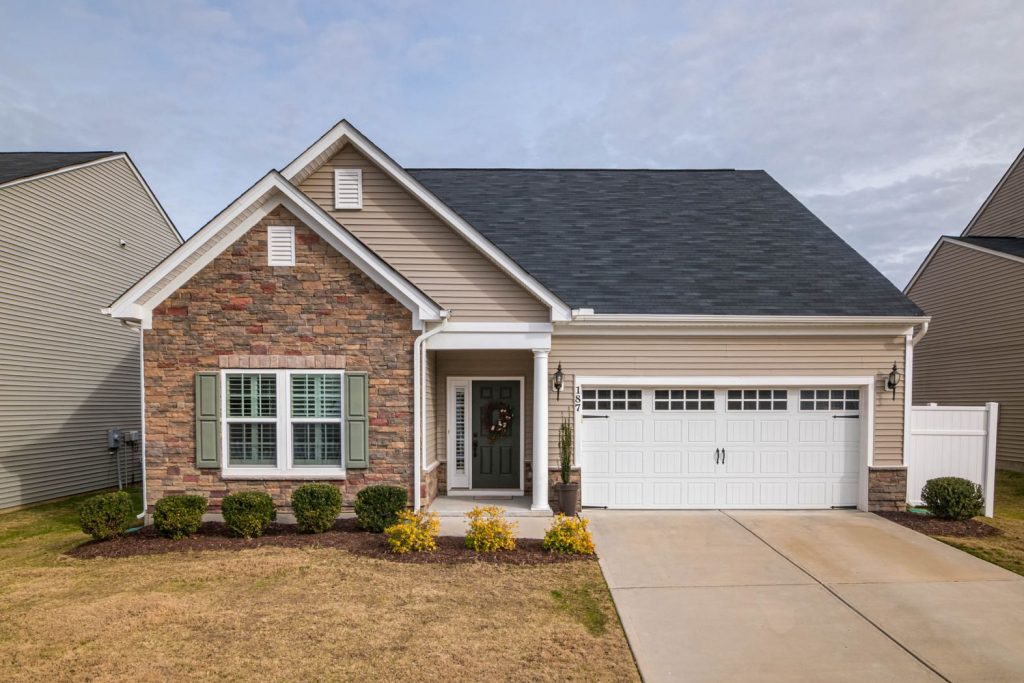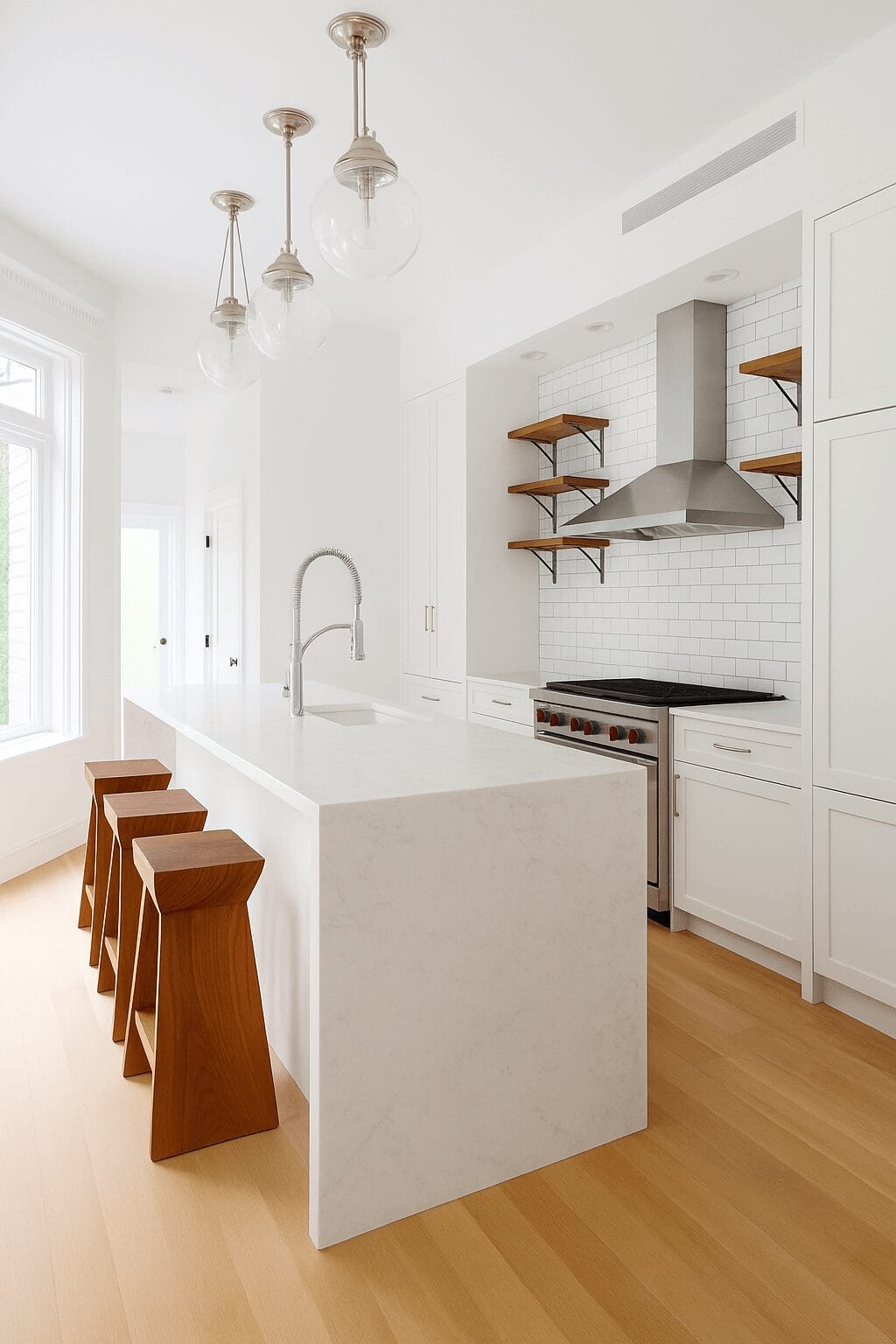Choosing between a one-story and two-story home isn’t just about adding a second floor. It’s about how your home fits your lifestyle, budget, lot, and long-term needs. Whether you’re building new, upgrading your current space, or weighing options before you buy, this guide compares the pros and cons of 1 story vs 2 story homes—from layout and livability to cost, energy use, and resale. In this blog, we’ll explore the pros and cons of each type of home and how you can decide when building a new custom home.
What Is a 1 Story House?
A one-story house places all living areas—kitchen, bedrooms, bathrooms, laundry—on the same level. No stairs. No split levels. Just one continuous floorplan.
These homes are especially popular among:
- Seniors or retirees planning to age in place
- Young families wanting safer layouts for toddlers
- Anyone looking for simplified maintenance and cleaning
Common styles: ranch, bungalow, transitional modern.
Thinking of building one? Learn more about our custom home process for single-story designs.
What Is a 2 Story House?
A two-story home spreads living space across two full levels. The main living areas typically sit on the ground floor, while bedrooms, bathrooms, and flex rooms are upstairs.
This layout is ideal for:
- Families who want zoned privacy (entertaining downstairs, bedrooms upstairs)
- Homeowners maximizing square footage on a smaller or narrow lot
- Those who prefer architectural variation and elevation
Common styles: colonial, craftsman, farmhouse, modern traditional.
1 Story vs 2 Story: Which One Fits You?
Let’s break this down by lifestyle, space, and functionality.


Lot Use, Layout, and Design Flexibility
One-Story Homes:
- Require larger lots to spread out horizontally
- May reduce backyard space unless the lot is deep
- Offer easy indoor-outdoor transitions and flow
Two-Story Homes:
- Use less land per square foot of living area
- Preserve yard or garden space
- Allow more creative rooflines, window placements, and visual interest
Building on a small or narrow lot? We help you optimize layout with custom design services.
Cost Comparison: Build Costs and Efficiency
You might assume one-story homes are cheaper. But per square foot, the opposite is often true.
| Factor | One-Story Home | Two-Story Home |
|---|---|---|
| Foundation + Roofing | Larger and more costly | Compact and cost-saving |
| Framing | Simpler layout | Additional stair and support |
| Plumbing & HVAC runs | Spread out across footprint | More compact, shorter runs |
| Price per Sq. Ft | $180–$240 | $160–$210 |
Realistic 2,000 Sq. Ft Estimate:
- One-story: $360K–$480K
- Two-story: $320K–$420K
Need a cost breakdown for your site and plan? Get in touch for a custom home quote.

Energy Use & Temperature Control
One-Story Homes
- Easier to heat and cool consistently
- Ideal for radiant flooring or geothermal systems
- Fewer vertical zones means even temperature throughout
Two-Story Homes
- Warm air rises → upstairs often hotter in summer
- Requires zoned HVAC or dual systems
- Can be more efficient on smaller lots (less roof area = less energy loss)
Efficiency Tip: Window placement and sun orientation often matter more than floor count. We plan these details during custom home design.
Noise, Privacy & Everyday Comfort
Noise Considerations
- One-story: Sound moves easily between rooms—TV noise, conversations, appliances.
- Two-story: Upstairs bedrooms feel more private, but foot traffic can be heard downstairs.
Privacy & Flow
- One-story: Promotes open-concept living, with less natural separation.


Maintenance: Inside & Out
Exterior
- One-story: Easier to clean gutters, inspect roof, paint siding
- Two-story: Requires ladders or professional maintenance
Interior
- One-story: All rooms on one level = easier to clean
- Two-story: More stairs, and twice the floor to vacuum
Homeowners often find that two-stories require slightly more upkeep, but gain flexibility in return.
Future-Proofing: Think Long-Term
If you’re building your “forever home,” consider:
- Will stairs become a problem in 10–20 years?
- Do you want to avoid relocating later in life?
- Will you be accommodating elderly family members or guests?
One-story homes:
- Naturally accessible
- Easy to retrofit with no-step entries, wider doors, or grab bars
- Often more attractive to aging buyers (higher resale potential)
Already own a one-story but need space? Consider a second-story addition to grow with your family.


Curb Appeal: How They Look
Two-story homes typically offer more variation:
- Taller, more dramatic profiles
- Features like balconies, dormers, and peaked roofs
- wo-story: Upstairs bedrooms feel more private, but foot traffic can be heard downstairs.
One-story homes have charm too:
- Wide porches, horizontal lines, and a grounded, cozy feel
- Work beautifully for modern, ranch, or transitional designs
Our custom design team can help you craft the look that fits your neighborhood and personality.
Resale Value & Market Trends
Your home’s layout can impact how fast it sells—and how much it’s worth.
One-Story Homes:
- High demand in retirement areas, downsizing markets
- Easier to market as “accessible”
- Ideal for buyers with limited mobility
Two-Story Homes:
- Higher resale in family-heavy suburbs and school districts
- Often priced higher per square foot
- Seen as more modern or “move-in ready” by younger buyers
Want to boost value before selling? Our home additions team can help you make the right upgrades.
Quick Recap: Pros and Cons
One-Story Homes:
Pros:
- Safer and easier access
- More even heating/cooling
- Easier maintenance
- Better for aging in place
Cons:
- Larger lot needed
- Less privacy between spaces
- Often higher per sq. ft. cost
Two-Story Homes:
Pros:
- More space on smaller lots
- Better separation of living and sleeping zones
- Dramatic exterior options
- Typically lower build cost per sq. ft.
Cons:
- Requires stairs
- Uneven temperatures between floors
- More maintenance for exterior and stairs

FAQs
Final Thoughts: Build the Home That Works for You
There’s no one-size-fits-all answer. Some people love the simplicity and accessibility of a one-story. Others thrive with the flexibility and separation of a two-story. At Top Home Builders Inc, we help you align your home with your life, land, and long-term goals—not just your square footage.
Ready to Build or Add On?
Let’s get your dream layout started:
Build smarter. Live better.

Related Article: Top Luxury Features for Homes in 2025
